What is the Via Crucis?
Fr. Juan David Rodríguez: The Via Crucis, also known as the Way of the Cross, is a Christian devotion that commemorates the events of Good Friday, the day Jesus was crucified. This practice has deep roots in Jerusalem, where pilgrims follow the Via Dolorosa—the path Jesus walked carrying His cross to Golgotha. One of the most significant traditions of this devotion is the Via Crucis led by the Franciscans every Friday afternoon.
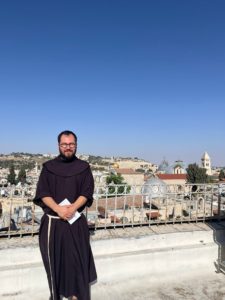
Friar Juan David Rodríguez
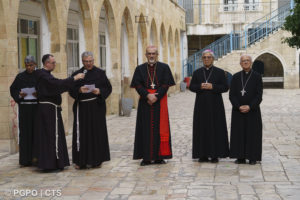
First Station: Jesus is condemned to death. The Latin Patriarch of Jerusalem, Card. Pierbattista Pizzaballa during the Way to the Cross
How did it originate?
Fr. Juan David: The Via Crucis has its origins in the Byzantine era. Travel diaries from early pilgrims, such as Egeria, a 4th-century pilgrim from the Iberian Peninsula, describe how believers walked through Jerusalem, visiting the places where Jesus underwent His trial, crucifixion, and resurrection. In the 17th century, Saint Leonard of Port Maurice, a Franciscan friar from Italy, formalized the practice by composing the 14 stations of the Via Crucis as we know them today. His goal was to spread the devotion globally, encouraging Christians everywhere to relive step-by-step the passion of Jesus Christ. Through this practice, he sought to bring believers closer to the redemptive fruits of Christ’s sufferings in Jerusalem.
Can you tell us some more about the Via Dolorosa in Jerusalem?
Fr. Juan David: The Via Dolorosa is a street in the Old City of Jerusalem, which follows the path Jesus walked on His way to the Crucifixion. The current route was established in the 18th century and includes fourteen stations, each representing a significant moment along Jesus’ journey from His condemnation to His burial. Key events along this path include Jesus meeting His mother, the assistance of Simon of Cyrene, and His three falls under the weight of the cross. The route we see today winds through the streets of Jerusalem as rebuilt by Suleiman the Magnificent around 1540. His rebuilding effort established much of the urban structure that remains in place today.
What is the role of the Franciscans in the custody of the Holy Land and in organizing the Via Crucis?
Fr. Juan David: The Franciscan Order has been present in the Holy Land since the 13th century, entrusted with the task of guarding sacred Christian sites. This land, marked by war and destruction over centuries, has seen periods when Christians were persecuted by followers of other religions. During such times, the Franciscans were responsible for rebuilding, conserving, and safeguarding key places connected to Jesus’ life, including Bethlehem, Jerusalem, Nazareth, and Capernaum. In addition to protecting these sites, the Franciscans have also safeguarded the lives of local Catholics and supported pilgrims from around the world who come to venerate these sacred places.
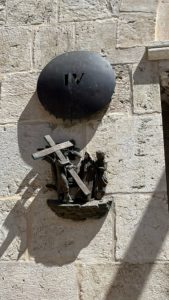
Fourth Station: Jesus is met by his Blessed Mother. Vía Dolorosa, Old City Jerusalem
In this context, the Franciscans, from the 13th century to the present, have accompanied pilgrims along the Way of the Cross, allowing them to venerate and pray at the same places where our Lord carried the Cross. The friars and pilgrims are accompanied by the kawas, who, although today are seen as a picture and element in Jerusalem, have been the official guards of the friars and the faithful since Ottoman times, escorting them as they pray the Via Crucis. While today it is safe to walk the streets of Jerusalem, centuries ago the presence of the kawas was necessary to protect the religious and pilgrims from being attacked or mistreated by people of other religions. Therefore, many Franciscan friars live in the Holy Land to protect the sacred sites and to also protect and accompany the Catholics living in the Holy Land, or visiting from around the world, so that they may see and pray in these places that were sanctified by the bodily presence of our Lord; in that way, through pilgrimage, the sacraments, and each one’s faith, they may thus obtain the fruits of redemption and eternal life that our Lord gave us through His passion and resurrection.
If you would like to join us in praying it, it takes place at 4 p.m. in summer and 3 p.m. in winter, starting from the First Station near the Lion’s Gate, at the Sanctuary of the Flagellation. After praying the Via Crucis, at the Holy Sepulcher, which is the final station, we conclude with the daily procession around the basilica, the Holy Calvary, and the site of the Resurrection.
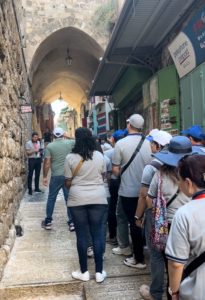
Pilgrims praying on the Way to the Cross, Via Dolorosa, Old City Jerusalem
How would you describe the experience of participating in the Via Crucis in Jerusalem?
Fr. Juan David: Participating in the Via Crucis in Jerusalem is a deeply spiritual experience. The faithful, accompanied by the Franciscans, walk slowly while praying and singing hymns. At each station, they stop to listen to Gospel readings and meditate on the suffering and redemption of Jesus. This practice not only recalls Jesus’ pain and sacrifice but also strengthens the faith and solidarity among participants. Additionally, it provides an opportunity to offer special petitions or prayers of thanksgiving to God.
What is the current atmosphere on the Via Dolorosa during the Via Crucis?
Fr. Juan David: Currently, the Via Crucis passes largely through the Muslim Quarter of Jerusalem. The city is divided into four quarters: Christian, Armenian, Jewish, and Muslim. As participants walk through the streets of the Muslim Quarter, they pass mosques, shops, vegetable markets, clothing stores, souvenir stalls, as well as restaurants and motorcycles, all accompanied by the scents of food. As pilgrims make their way toward the Holy Sepulcher, singing and praying, local residents—both Muslims and Jews—often do not understand what is taking place. Some observe with surprise, a few shout insults, and others spit on the ground as a gesture related to their beliefs. For the participants, this experience mirrors Christ’s Passion: Jesus was seen by onlookers as an ordinary man, condemned to die, with no one realizing that He was the Messiah, the Savior, the Son of God, and God Himself, who died and rose again in this very place. The Via Crucis in Jerusalem is to unite to Jesus in His silent death so we can share in His silent resurrection and glory.
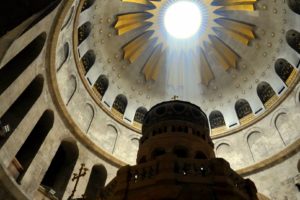
Fourteenth Station: Jesus is laid in the tomb, Church of the Holy Sepulcher, photo by Silvany
